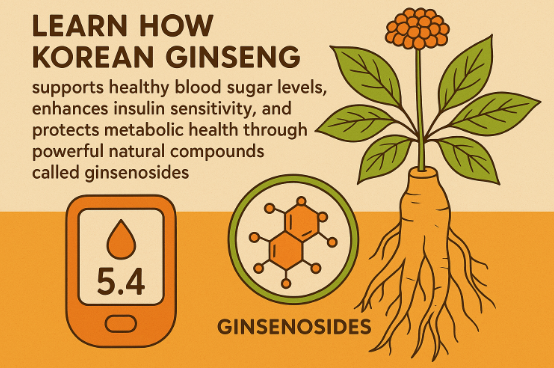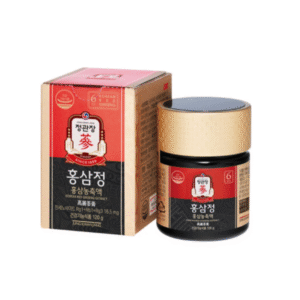Blood sugar balance is one of the cornerstones of long-term health. Yet, in today’s fast-paced lifestyle—characterized by high stress, poor sleep, and processed foods—more people than ever face metabolic challenges such as insulin resistance, prediabetes, and type 2 diabetes.
While modern medicine offers essential treatments, scientists have also turned to nature’s pharmacology for complementary support. Among natural compounds, Korean Red Ginseng (Panax ginseng Meyer) has gained growing recognition for its ability to help regulate blood glucose and improve insulin sensitivity in a scientifically measurable way.
This article explores how Korean Red Ginseng works within the body to support metabolic balance, backed by biological mechanisms and clinical evidence.
Understanding Blood Sugar and Insulin Function
Blood glucose is the primary energy source for the body’s cells. To maintain stable levels, the pancreas releases insulin, a hormone that allows cells to absorb glucose from the bloodstream.
However, when this system is disrupted—due to chronic stress, inflammation, excess body fat, or poor diet—cells become less responsive to insulin, a condition known as insulin resistance.
Over time, this can lead to elevated blood sugar, oxidative stress, and eventually type 2 diabetes.
A key factor in controlling this process is reducing oxidative damage and inflammation in tissues, especially in the liver, pancreas, and muscles. This is where adaptogenic herbs like Korean Red Ginseng may offer unique support.
What Makes Korean Red Ginseng Unique
Korean Red Ginseng differs from other ginseng varieties (such as American or Chinese) in both its processing and chemical profile.
Through a meticulous steaming and drying process, the root undergoes natural transformation—enhancing its concentration of rare compounds like ginsenosides Rg3, Rg5, and Rh2, which are not abundant in unprocessed ginseng.
These ginsenosides are bioactive molecules that interact with multiple metabolic pathways, helping to:
- Improve glucose uptake in muscle cells
- Enhance insulin sensitivity
- Reduce oxidative stress and inflammation in metabolic tissues
- Support the health of pancreatic beta cells, which produce insulin
Ginsenosides: The Key to Glucose Regulation
The pharmacological effects of Korean Red Ginseng stem from its ginsenosides, natural compounds with antioxidant, anti-inflammatory, and adaptogenic properties.
1. Ginsenoside Rb1
- Enhances glucose transporter (GLUT4) activity in skeletal muscle.
- Promotes efficient glucose uptake and utilization.
2. Ginsenoside Rg3
- Regulates insulin receptor signaling, improving insulin sensitivity.
- Reduces fat accumulation in the liver (hepatic steatosis).
3. Ginsenoside Re and Rg1
- Lower oxidative stress and inhibit inflammatory cytokines like TNF-α and IL-6.
- Protect pancreatic cells from glucose toxicity.
4. Ginsenoside Rh2
- Modulates adipokine secretion, supporting balanced energy metabolism.
Together, these ginsenosides create a multifunctional effect: they not only reduce blood sugar levels but also strengthen the body’s natural mechanisms for maintaining metabolic homeostasis.
Clinical Evidence: What Studies Show
Scientific studies have provided compelling evidence that Korean Red Ginseng can positively affect glucose metabolism and insulin function.
- A 2014 study in the journal Diabetes Research and Clinical Practice found that 2 grams of Korean Red Ginseng daily for 8 weeks significantly lowered fasting blood glucose levels and improved insulin sensitivity in adults with prediabetes.
- A clinical trial published in the Journal of Ginseng Research (2016) observed that patients with type 2 diabetes taking 3 grams of red ginseng daily showed notable improvements in post-meal glucose response compared with placebo.
- Animal models have shown that ginsenosides enhance the activity of enzymes like AMP-activated protein kinase (AMPK), which regulates energy balance and glucose uptake.
- A 2020 meta-analysis of randomized controlled trials concluded that Korean Red Ginseng supplementation led to modest but significant improvements in fasting glucose and HbA1c levels, especially when combined with lifestyle interventions such as diet and exercise.
These findings suggest that Korean Red Ginseng acts not as a replacement for conventional therapy but as a natural adjunct that complements medical treatment and lifestyle management.
Mechanisms Behind Blood Sugar Regulation
Korean Red Ginseng influences multiple pathways related to glucose metabolism:
🧬 1. Enhancing Insulin Sensitivity
Ginsenosides help insulin bind more effectively to its receptors, improving glucose uptake into cells. This can reduce the burden on the pancreas and stabilize blood sugar fluctuations.
🔥 2. Reducing Oxidative Stress
High blood sugar produces reactive oxygen species (ROS) that damage cells. Ginseng’s antioxidant enzymes, such as superoxide dismutase (SOD) and glutathione peroxidase (GPx), neutralize these radicals, protecting insulin-producing cells.
❤️ 3. Protecting Pancreatic Beta Cells
Chronic hyperglycemia can exhaust pancreatic beta cells. Ginsenoside Rb1 supports their survival by modulating the Nrf2 signaling pathway, which enhances cellular defense mechanisms.
💪 4. Regulating Lipid Metabolism
By reducing triglycerides and improving cholesterol balance, ginseng indirectly supports insulin function and cardiovascular health—two systems closely linked in metabolic syndrome.
Adaptogenic Support Under Metabolic Stress
One of the most fascinating aspects of Korean Red Ginseng is its adaptogenic property—its ability to restore physiological balance under stress.
Metabolic disorders often coincide with chronic stress, which activates the HPA axis and elevates cortisol levels. Prolonged cortisol elevation promotes insulin resistance.
Research shows that ginseng modulates cortisol secretion and supports a calmer, more balanced stress response, indirectly protecting blood sugar regulation.
This dual action—reducing metabolic stress while improving glucose metabolism—positions Korean Red Ginseng as a truly holistic metabolic adaptogen.
Safety and Dosage Considerations
Korean Red Ginseng is generally safe for long-term use when consumed in recommended amounts.
Most clinical studies have used doses between 1 to 3 grams daily, equivalent to 200–800 mg of standardized extract.
Mild side effects such as sleeplessness or digestive upset may occur in sensitive individuals, especially if taken in excessive amounts or alongside caffeine.
As with all supplements, individuals on antidiabetic or antihypertensive medications should consult a healthcare professional before use to prevent potential interactions.
Integrating Ginseng into a Healthy Lifestyle
Korean Red Ginseng is not a standalone cure but part of a broader approach to metabolic health. For best results, combine it with:
- A balanced, low-glycemic diet rich in vegetables and fiber.
- Regular physical activity to improve insulin sensitivity.
- Adequate sleep and stress management, which regulate cortisol and blood glucose.
When used consistently, Korean Red Ginseng can help stabilize daily energy levels, reduce sugar cravings, and support long-term glucose homeostasis.
Conclusion
Modern research validates what traditional medicine has known for centuries: Korean Red Ginseng is a remarkable adaptogen that promotes metabolic harmony.
Through its unique ginsenosides, it enhances insulin function, reduces oxidative stress, and supports the body’s natural ability to maintain healthy blood sugar levels.
For individuals seeking a scientifically supported, natural ally in blood sugar management, Korean Red Ginseng represents both tradition and innovation—a bridge between ancient wisdom and modern metabolic science.
🇰🇷 Premium Korean Ginseng Online Shop







